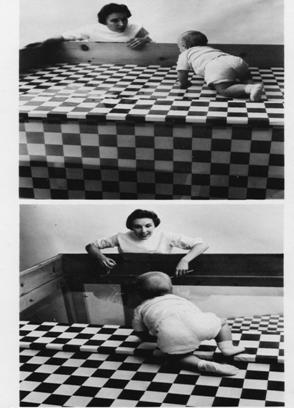沃克和吉布森(Walk & Gibson,1961)曾进行了一项旨在研究婴儿深度视觉的实验--"视觉悬崖"(如图所示)实验,后来被称为发展心理学的经典实验之一。研究者制作了平坦的棋盘式的图案,用不同的图案构造以造成"视觉悬崖"的错觉,并在图案的上方覆盖玻璃板。将2~3个月大的婴儿腹部向下放在"视觉悬崖"的一边,发现婴儿的心跳速度会减慢,这说明他们体验到了物体深度:当把6个月大的婴儿放在玻璃板上,让其母亲在另一边招呼婴儿时,发现婴儿会毫不犹豫地爬过没有深度错觉的一边,但却不愿意爬过看起来具有悬崖特点的一边,纵使母亲在对面怎么叫也一样。这似乎说明婴儿已经具备了深度知觉,但这种深度知觉是与生俱来的,还是在出生后几个月里学来的,目前还没有定论。
Experimental psychologist noted for her work in the field of perceptual development in children and infants. In 1975 Gibson was able to establish her own infant study laboratory. This enabled her to devote her research to ecological psychology, perhaps even more so after her husband's death in 1979. She has pursued her work on perceptual development, more recently concentrating on the concept of affordance. Gibson's major published work is possibly An Odyssey in Learning and Perception, (1991), which consolidates much of her lifetime's work. She also wrote Principles of Perceptual Learning and Development, in 1967, for which she received the Century Award.
In 1975 Gibson was able to establish her own infant study laboratory. This enabled her to devote her research to ecological psychology, perhaps even more so after her husband's death in 1979. She has pursued her work on perceptual development, more recently concentrating on the concept of affordance. Gibson's major published work is possibly An Odyssey in Learning and Perception, (1991), which consolidates much of her lifetime's work. She also wrote Principles of Perceptual Learning and Development, in 1967, for which she received the Century Award.
Gibson, along with her husband, J.J. Gibson, argued that perceptual learning was done through a process called differentiation. Before perceptual learning, we over-generalize and see things similarly to each other. As we develop perceptual learning we can make distinctions between objects and events that we were not able to make initially. Simply, as young children, we easily confuse stimuli with one another, but with repetition, the stimuli eventually become differentiated from one another (Benjafield, 1996, p. 259).
Probably the most well known contribution of E.J. Gibson is the visual cliff. The visual cliff was developed to investigate the process of depth perception, or seeing objects in three dimensions. E.J. Gibson and Richard Walk (1960) studied infant’s depth perception by using a small cliff with a drop-off covered by glass. Gibson and Walk would then place 6-14 month old infants on the edge of the visual cliff to see if they would crawl “over the edge”. Most infants refused to crawl out on the glass signifying that they could perceive depth and that depth perception is not learned
http://teach.psy.uga.edu/dept/student/parker/PsychWomen/Gibson.htm
http://www.findarticles.com/cf_dls/g2699/0004/2699000482/p1/article.jhtml

